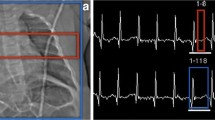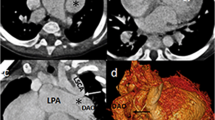Abstract
Objective
The purpose of this study was to investigate whether the origins and courses of the coronary arteries could be better assessed using ECG-gated dual-source computed tomography (CT) than with echocardiography in neonates with transposition of the great arteries (TGA).
Methods
A total of 17 neonates within 14 days old who underwent both echocardiography and retrospective ECG-gated coronary CT angiography were retrospectively reviewed. The patients were sedated and intubated during CT examinations, and CT images were obtained with a breath-hold. CT images were reconstructed by multiple cardiac phases, and the coronary artery assessment was performed in the most static phase. Coronary anomalies were classified by Shaher’s classification and validated by surgical findings.
Results
CT correctly classified 16 of 17 cases (Shaher type 1: 7, type 2: 4, type 9: 3, type 3: 1, type 4: 2), whereas echocardiography classified only 8 of 17 cases correctly. Dual-source CT had a significantly higher diagnostic ability than echocardiography (p = 0.0078).
Conclusion
Dual-source coronary CT angiography has a higher diagnostic ability than echocardiography in the assessment of the origins and courses of the coronary arteries in neonates with TGA.



Similar content being viewed by others
Abbreviations
- ECG:
-
Electrocardiogram
- TGA:
-
Transposition of the great arteries
- CHD:
-
Congenital heart disease
- ASO:
-
Arterial switch operation
- MDCT:
-
Multi-detector row computed tomography
- VR:
-
Volume rendering
- MPR:
-
Multiplanar reformation
- CTDIvol :
-
Volume CT dose index
- DLP:
-
Dose-length product
- SD:
-
Standard deviation
- TTE:
-
Transthoracic echocardiography
- LCX:
-
Left circumflex artery
- RCA:
-
Right coronary artery
- LAD:
-
Left anterior descending artery
References
Hoffman JIE, Kaplan S. The incidence of congenital heart disease. J Am Coll Cardiol. 2002;39:1890–900.
Ferencz C, Rubin JD, Loffredo CA, et al. Epidemiology of congenital heart disease: the Baltimore–Washington Infant Study, 1981–1989. Mount Kisco: Futura Publishing; 1993.
Fyler DC, Buckley LP, Hellenbrand WE, et al. Report of the New England Regional Infant Cardiac Program. Pediatrics. 1980;65(suppl):375–461.
Samanek M. Congenital heart malformations: prevalence, severity, survival, and quality of life. Cardiol Young. 2000;10:179–85.
Ferencz C, Rubin JD, McCarter RJ, et al. Congenital heart disease: prevalence at livebirth. Am J Epidemiol. 1985;121:31–6.
Samanek M, Voriskova M. Congenital heart disease among 815,569 children born between 1980 and 1990 and their 15-year survival: a prospective Bohemia survival study. Pediatr Cardiol. 1999;20:411–7.
Angeli E, Formigari R, Pace Napoleone C, Oppido G, Ragni L, Picchio FM, Gargiulo G. Long-term coronary artery outcome after arterial switch operation for transposition of the great arteries. Eur J Cardiothorac Surg. 2010;38(6):714–20.
Khairy P, Clair M, Fernandes SM, Blume ED, Powell AJ, Newburger JW, Landzberg MJ, Mayer JE Jr. Cardiovascular outcomes after the arterial switch operation for D-transposition of the great arteries. Circulation. 2013;127(3):331–9.
Pasquali SK, Hasselblad V, Li JS, Kong DF, Sanders SP. Coronary artery pattern and outcome of arterial switch operation for transposition of the great arteries: a meta-analysis. Circulation. 2002;106(20):2575–80.
Goitein O, Salem Y, Jacobson J, et al. The role of cardiac computed tomography in infants with congenital heart disease. Israel Med Assoc. 2014;16:147–52.
Tada A, Sato S, Kanie Y, et al. Image quality of coronary computed tomography angiography with 320-row area detector computed tomography in children with congenital heart disease. Pediatr Cardiol. 2016;37:497–503.
Kanie Y, Sato S, Tada A, et al. Image quality of coronary arteries on non-electrocardiography-gated high pitch dual-source computed tomography in children with congenital heart disease. Pediatr Cardiol. 2017. https://doi.org/10.1007/s00246-017-1675-9.
Yamasaki Y, Kawanami S, Kamitani T et al. Patient-related factors influencing detectability of coronary arteries in 320- row CT angiography in infants with complex congenital heart disease. Int J Cardiovasc Imaging. 2018; [Epub ahead of print]. https://doi.org/10.1007/s10554-018-1363-8.
Chiu IS, Chu SH, Wang JK, Wu MH, Chen MR, Cheng CF, et al. Evolution of coronary artery pattern according to short-axis aortopulmonary rotation: a new categorization for complete transposition of the great arteries. J Am Coll Cardiol. 1995;26(1):250–8.
Thomas KE, Wang B. Age-specific effective doses for pediatric MSCT examinations at a large children’s hospital using DLP conversion coefficients: a simple estimation method. Pediatr Radiol. 2008;38:645–56. https://doi.org/10.1007/s00247-008-0794-0.
American Association of Physicists in Medicine. Size-specific dose estimates (SSDE) in pediatric and adult body CT Examinations: report of AAPM Task Group 204. College Park: American Association of Physicists in Medicine; 2011.
Xie L, Jiang L, Yang Z, et al. Assessment of transposition of the great arteries associated with multiple malformations using dual-source computed tomography. PLoS ONE. 2017;12(11):e0187578. https://doi.org/10.1371/journal.pone.0187578.
Goo HW. Identification of coronary artery anatomy on dual-source cardiac computed tomography before arterial switch operation in newborns and young infants: comparison with transthoracic echocardiography. Pediatr Radiol. 2018;48(2):176–85.
Acknowledgements
This work was supported by the Japan Society for the Promotion of Science (JSPS) KAKENHI (17K16452).
Author information
Authors and Affiliations
Corresponding author
Ethics declarations
Conflict of interest
Yamasaki Y: Bayer Healthcare Japan, Modest, Research Grant; Philips Electronics Japan, Modest, Research Grant. Other authors declare that they have no conflict of interest.
Ethical approval
Institutional Review Board approval at Fukuoka Children’s Hospital was obtained.
Informed consent
Written informed consent was waived due to the retrospective nature of the research.
Additional information
Publisher's Note
Springer Nature remains neutral with regard to jurisdictional claims in published maps and institutional affiliations.
About this article
Cite this article
Odawara, Y., Kawamura, N., Yamasaki, Y. et al. Evaluation of coronary artery variations using dual-source coronary computed tomography angiography in neonates with transposition of the great arteries. Jpn J Radiol 37, 308–314 (2019). https://doi.org/10.1007/s11604-018-00807-x
Received:
Accepted:
Published:
Issue Date:
DOI: https://doi.org/10.1007/s11604-018-00807-x




